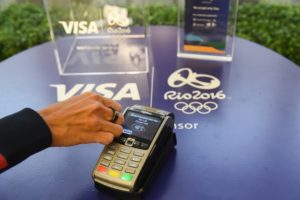
The Rio Olympics were spectacular, providing moments of inspiration, jaw-dropping displays of technique, and explosive speed and power. Few will forget Usain Bolt’s triple-triple, Simone Biles’ near-flawless debut or the sporting moment New Zealander Nikki Hamblin and American Abbey D’Agostino helped each other finish their race following a fall.
But the athletes weren’t the only stars of the show this year. The Olympics provided the perfect test for the latest wearable technologies to shine. This year in Rio we partnered with RioCard, Rio’s transport ticketing operator to launch a pilot with a contactless wristband for visitors to the Games. This wearable, when fully implemented, will be an amazing tool, helping citizens get everywhere in Brazil’s most beautiful city with ease.
But we weren’t finished there, and together with Visa launched a revolutionary wearable payment ring. A secure chip and an antenna are embedded within the ceramic loop, and allowed athletes to pay for food and drink within the athletes’ village and other venues. It was warmly received by athletes who are constantly changing in and out of training kit, making it really easy to misplace their wallets. The ring can stay on no matter what, allowing the competitors to concentrate on what mattered – namely going for Gold!
These pilots are now complete, but it’s important to remember how important trials of this type are. The London 2012 Games were hailed as the first contactless Games, and commitment to the technology there really kick-started a revolution in Britain. Now contactless is becoming the method of choice for transport and payments, and we have similar high hopes for the impact of the Rio Games on wearable technology.
Sports is actually the ideal area for wearables. We’ve covered before how the Internet of Things is being applied to boxing, rugby, tennis, and American Football through wearable sensors. And advancements in the technology is also starting to have a profound effect on the fan experience too.
We’ve partnered with Saracens rugby club to allow fans to travel to and from the game, and pay for food and club merchandise while there with a club branded wristband. And at this year’s European football championships, we teamed up with host-city Lille so that fans could get around the city using contactless bands. These bands continue to work on the buses, trams and metro even though the tournament has long since ended.
The wearable revolution will continue, and at Tokyo 2020, there are hopes it will be the most technologically advanced yet. Plans could allow visitors to arrive via a driverless car and enter the venues via a wearable device. Facial recognition could verify ticket holders, apps will guide fans to their seats in their own language, and they might even be able to pay for things with their fingerprint.
It is worth pointing out that the last time Japan hosted the Olympics in 1964, they launched the world-famous bullet train to coincide with the opening. That investment in transport infrastructure helped boost the country’s economy, and allowed Japan to become a global leader in high-speed rail.
With driverless cars, the Internet of Things, biometrics and wearables all the cards for Tokyo, the 2020 Games could continue the legacy of technology innovation.
What technologies would you like to see at sporting events, and are there any wearable ideas of your own that you think should be developed? Let us know @Gemalto or in the comments below.


